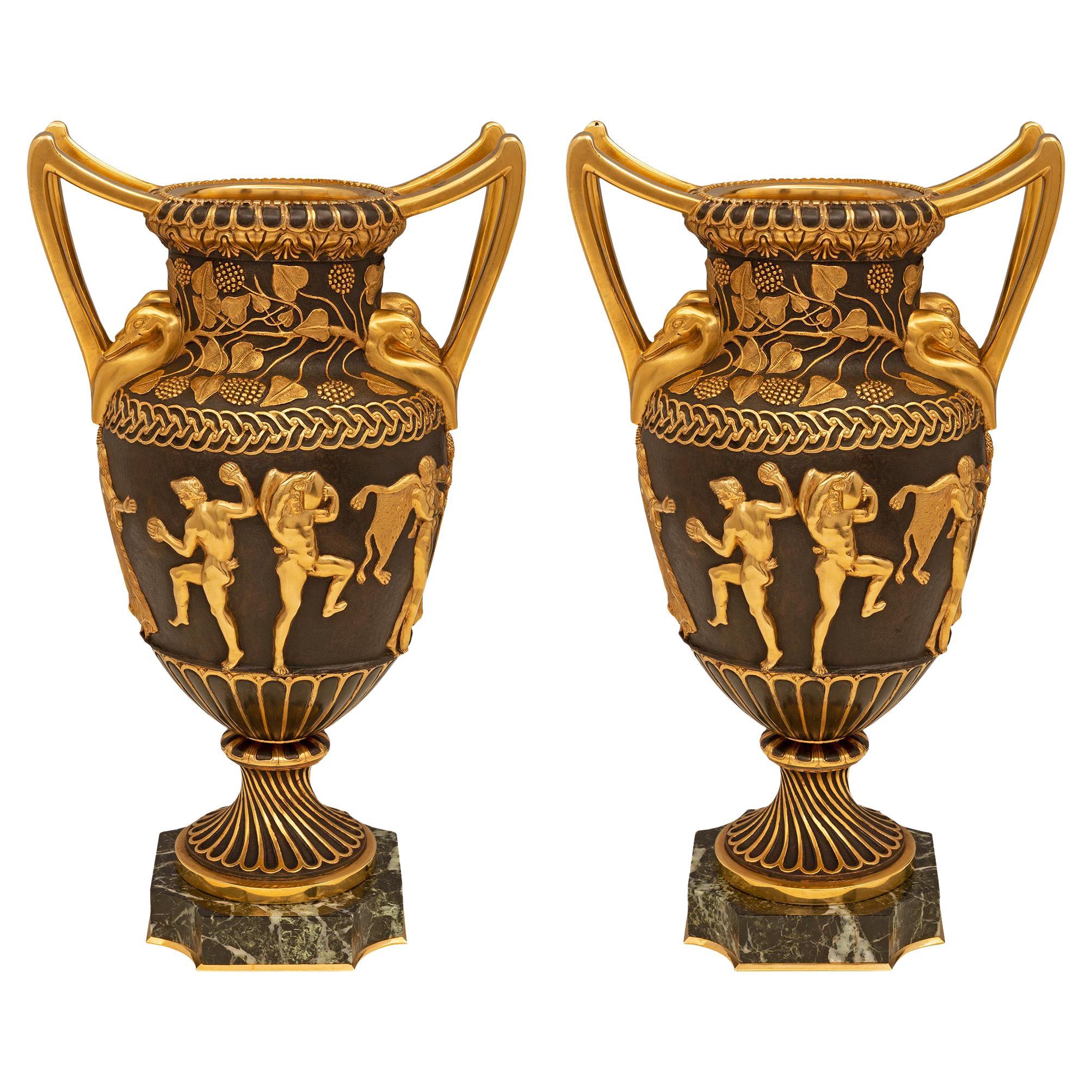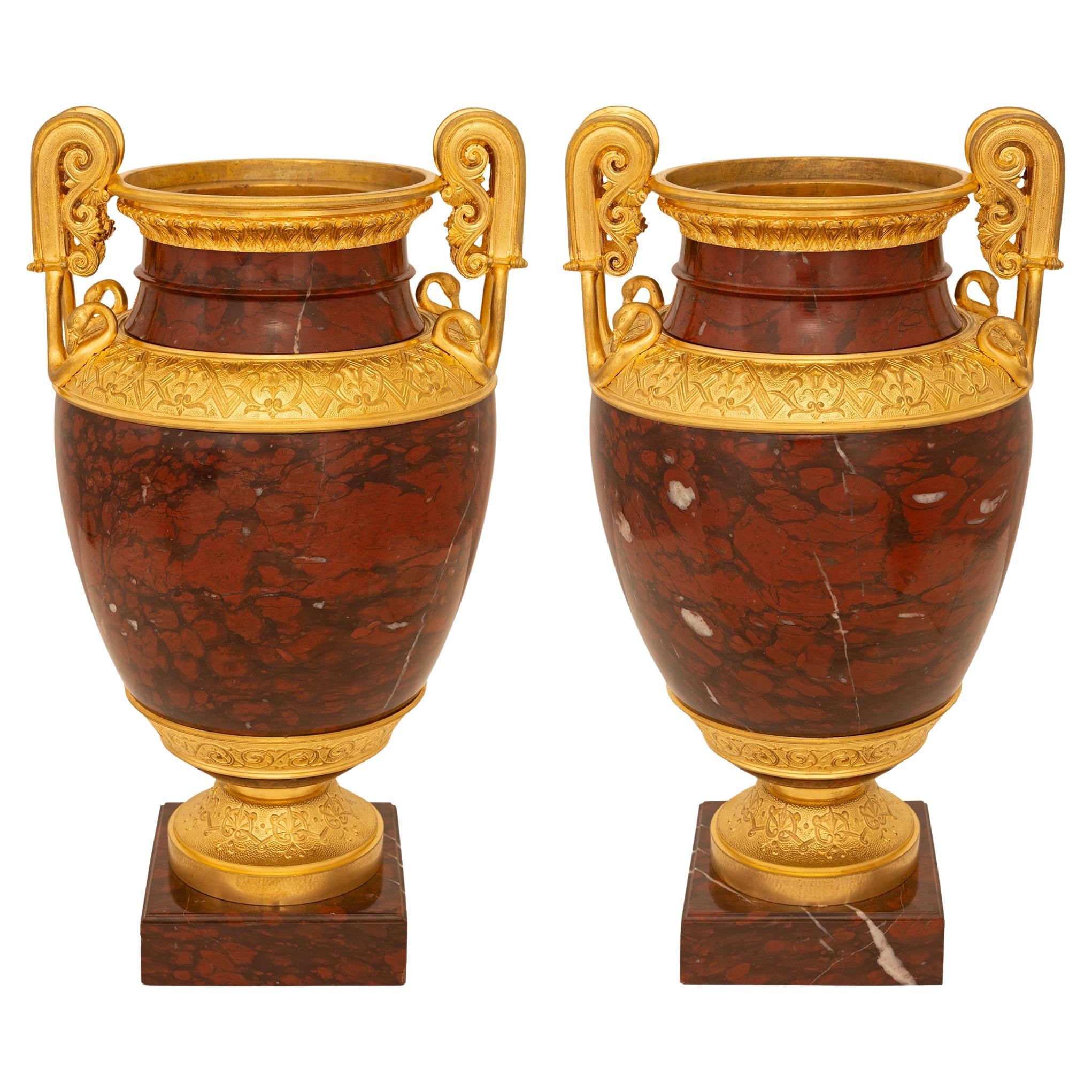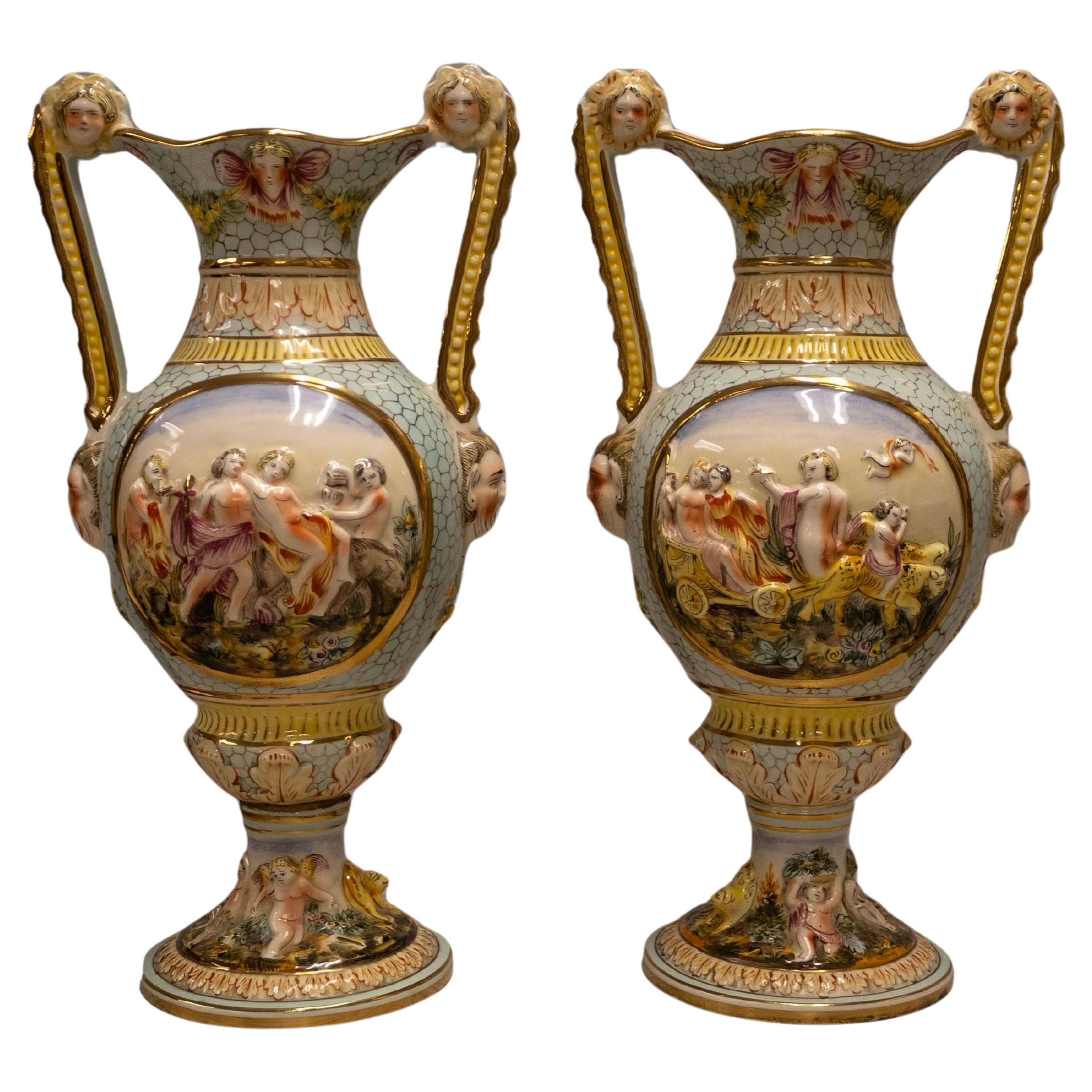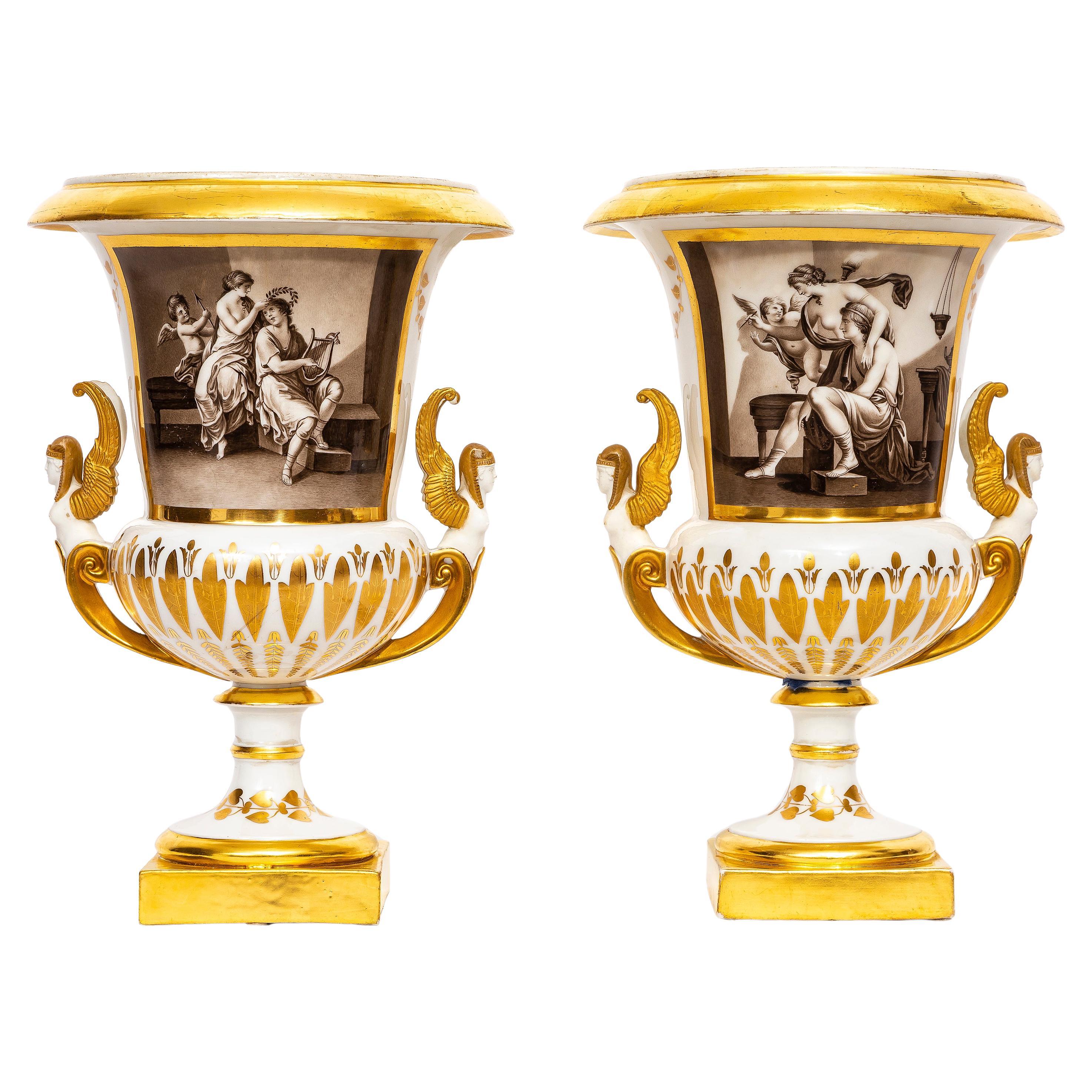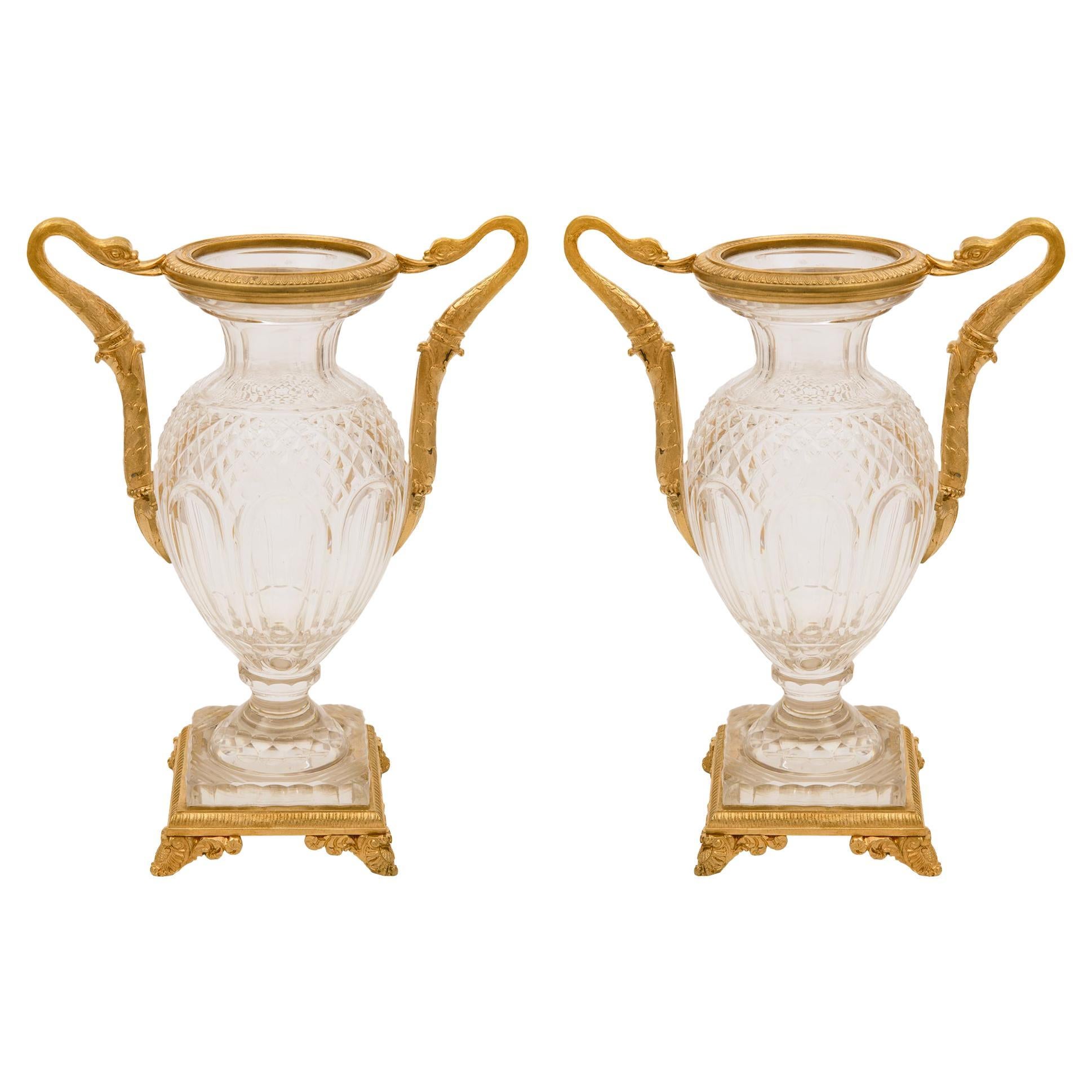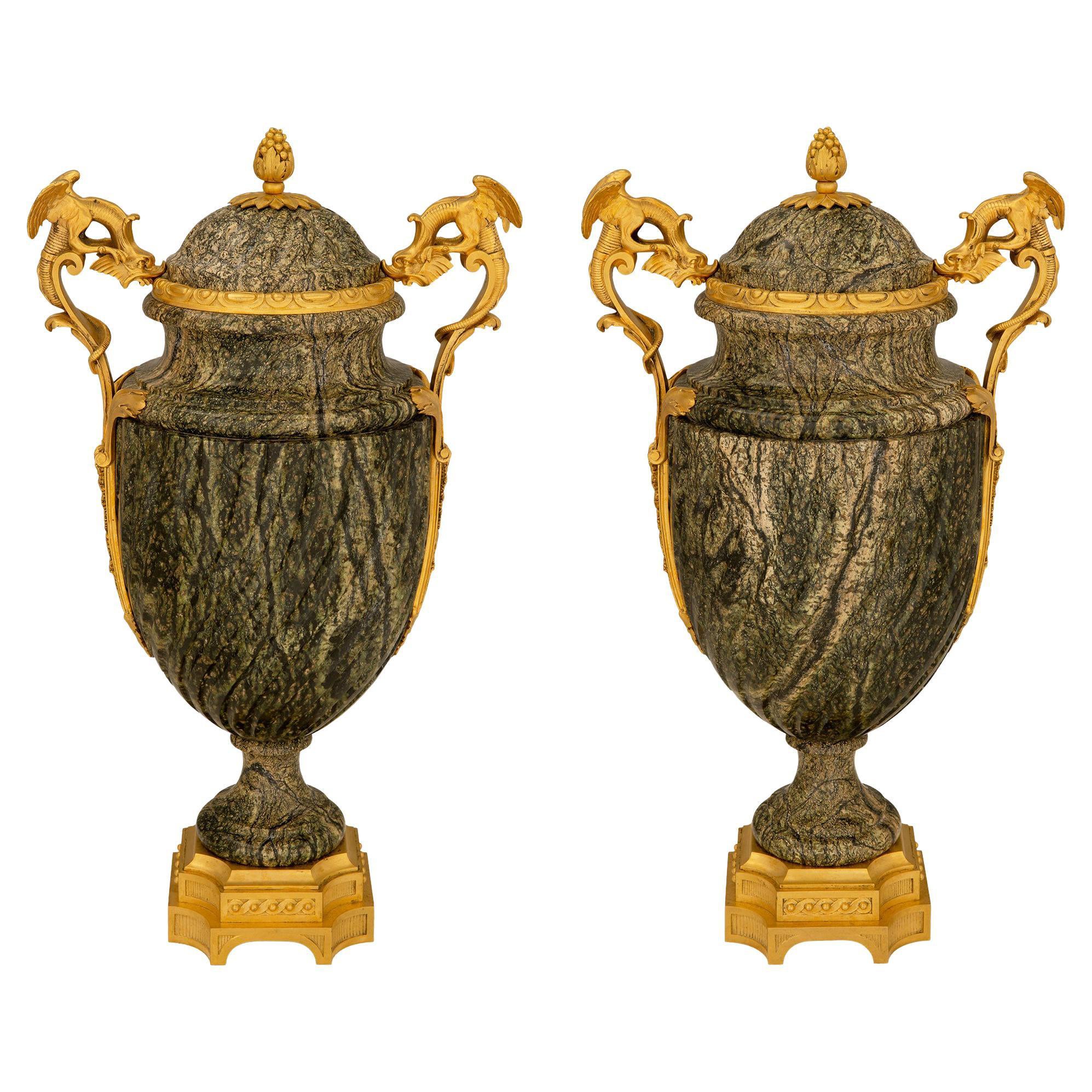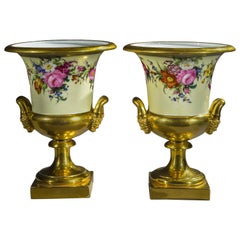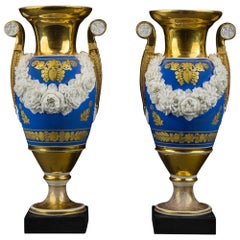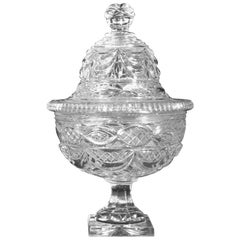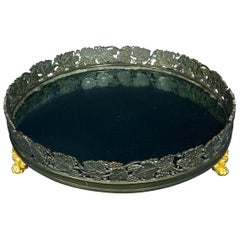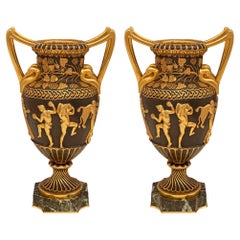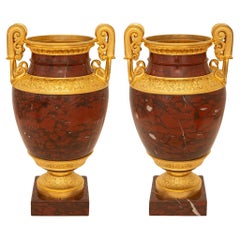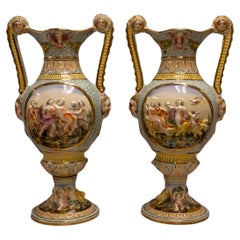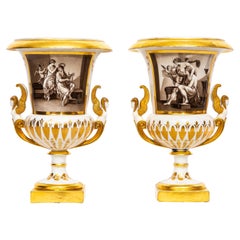Items Similar to Pair of Porcelain Urn Form Fruit Coolers with Covers and Liners
Want more images or videos?
Request additional images or videos from the seller
1 of 6
Pair of Porcelain Urn Form Fruit Coolers with Covers and Liners
$35,000per set
£26,540.45per set
€30,708.53per set
CA$49,473.77per set
A$55,153.75per set
CHF 28,764.95per set
MX$666,936.69per set
NOK 361,589.52per set
SEK 342,135.95per set
DKK 229,207.85per set
About the Item
Pair Footed Fruit Coolers, about 1810-20
Stône, Coquerel, and Legros D’Anisy, Paris (active 1808–49)
Porcelain, partially transfer printed in sepia and green and gilded
Each, 13 1/2 in. high x 10 in. wide x 7 1/2 in. deep
Signed and inscribed (on underside of one top and one base, with printed mark): STÔNE /
COQUEREL / ET / LE GROS / PARIS / PAR BREVET D’INVENTION: Manufre de Décors sur
Porcelaine Faience; variously inscribed with decorators’ initial in green and brown (on
underside of one top and one base): M; variously inscribed with incised mark (on underside of one liner and both bottoms): 3; inscribed (in blue script, on the inside of one liner): 615
The Parisian firm of Stône, Coquerel, and Legros d'Anisy is distinguished for the important role that it played in the introduction of transfer-printed decoration on fine china in France. Although the process had been known and used in Great Britain since the eighteenth century, it was, according to Régine de Plinval de Guillebon in her book, Porcelain of Paris 1770–1850 (New York: Walker and Company, 1972), not until 1802 that Potter, Blancheron, Constant, Neppel, Cadet de Vaux & Denuelle took out a patent in France for transfer-printing on earthenware, and it was only on February 26, 1808, that John Hurford Stône, his brother-in-law, Athanase Marie Martin Coquerel, and Francois Antoine Legros d'Anisy not only took out a patent for transfer-printing on china, but also established a Stône, Coquerel, and d'Anisy partnership for the manufacture of transfer-printed ceramics. Their address from 1808 until 1818 was at 9, rue de Cadran, Paris.
Prior to this, Stône and Coquerel had been partners at a creamware factory in Creil, France, and Legros d’Anisy had worked at the Sèvres factory, where he had apparently developed the transfer-printing technique for which his own firm became well known. “The process,” notes de Guillebon, was “based upon removing from the engraving a ‘pull’ made on a specially coated filter-paper, which was pressed onto the object to be decorated; this object itself was covered with a film. Firing took place in a muffle-kiln” (p. 262). Stone “was responsible for management and general supervision, ... Coquerel was just a signatory [and], as for Legros d'Anisy, the technician, his tasks were to select suitable subjects for reproduction, to fix prices, and to choose and manage the painters and engravers.”
De Guillebon (p. 264) cites the Almanach du Commerce de la Ville de Paris of 1808, which listed the various subjects that were used by the firm of Stône, Coquerel, and d'Anisy, including the fables of La Fontaine, portraits of great men both ancient and modern, picturesque views, castles and country houses in different lands, highlights from French and Roman history, monuments of Paris and its environs, engraved stones, and military service. The Almanach further noted that “all these decorations could be turned out in black or in colour, and this applies equally to any subjects that might be requested: monograms, armorial bearings, family portraits, etc.”
In contrast to the clumsy decorative effects often resulting from the transfer-printing process, the decorations of Stône, Coquerel, and d'Anisy were “remarkable for their delicacy and clarity” (de Guillebon, p. 264), which is confirmed not only by the splendid quality of the present pair of coolers, but also by the huge assortment of subjects used to decorate their wares. Complementing the transfer-printed scenes, these coolers are adorned with a variety of neo-classical borders–floral, foliate, and geometric–both transfer-printed and free drawn.
- Creator:Stône, Coquerel, and Legros d'Anisy (Artist)
- Dimensions:Height: 13 in (33.02 cm)Width: 10 in (25.4 cm)Depth: 7 in (17.78 cm)
- Sold As:Set of 2
- Style:Neoclassical (In the Style Of)
- Materials and Techniques:
- Place of Origin:
- Period:
- Date of Manufacture:circa 1810-1820
- Condition:Repaired: A chip to the underside of the rim of one liner was expertly and invisibly repaired. Wear consistent with age and use. Excellent. Unlike many coolers of the period, these retain their original covers and liners. Some minor wear to the gilding and decoration as expected due to age.
- Seller Location:New York, NY
- Reference Number:Seller: FAPG 21240D1stDibs: LU903227803432
About the Seller
No Reviews Yet
Recognized Seller
These prestigious sellers are industry leaders and represent the highest echelon for item quality and design.
Established in 1952
1stDibs seller since 2010
Associations
Art Dealers Association of America
- ShippingRetrieving quote...Shipping from: New York, NY
- Return Policy
Authenticity Guarantee
In the unlikely event there’s an issue with an item’s authenticity, contact us within 1 year for a full refund. DetailsMoney-Back Guarantee
If your item is not as described, is damaged in transit, or does not arrive, contact us within 7 days for a full refund. Details24-Hour Cancellation
You have a 24-hour grace period in which to reconsider your purchase, with no questions asked.Vetted Professional Sellers
Our world-class sellers must adhere to strict standards for service and quality, maintaining the integrity of our listings.Price-Match Guarantee
If you find that a seller listed the same item for a lower price elsewhere, we’ll match it.Trusted Global Delivery
Our best-in-class carrier network provides specialized shipping options worldwide, including custom delivery.More From This Seller
View AllPair of Medici-Form Vases
Located in New York, NY
Attributed to Schoelcher, Paris, France, circa 1830.
Porcelain, painted and gilded.
16 1/4 in. high, 9 1/2 in. wide, 9 1/2 in. deep.
Ex Coll.: by repute, Joseph Bonaparte...
Category
Antique Mid-19th Century French Empire Porcelain
Materials
Porcelain
$25,000 / set
Pair of "Old Paris" Vases with Garlands of Bisquit Flowers
Located in New York, NY
French, circa 1820.
Porcelain, painted and gilded, with applied bisquit flowers
8 13/16 in. high.
Inscribed (with incised mark, under the base of each): 3.
Category
Antique 1820s French Neoclassical Porcelain
Materials
Porcelain
Monumental Clear Cut-Glass Covered Compote
Located in New York, NY
Monumental clear cut-glass covered compote, circa 1820.
La Cristallerie de Vonêche (active 1802-30), Belgium.
Glass, blown and cut.
Measures: 17 3/8 i...
Category
Antique Early 19th Century Belgian Neoclassical Tableware
Materials
Blown Glass, Cut Glass
Plateau in the Restauration Taste with Grape and Leaf Motifs
Located in New York, NY
French.
Plateau in the Restauration taste with grape and leaf motifs, circa 1825.
Ormolu and patinated bronze, with mirror plate and wood backing.
Measures: 15 7/8 in. diameter, 3 11...
Category
Antique 1820s French Neoclassical Platters and Serveware
Materials
Bronze
Pair of Fern Wall Brackets
Located in New York, NY
American, circa 1850-1880.
Eastern white pine (Pinus strobus), with wire armature and composition ornament, gessoed
and gilded.
Measures: 14 1/8 in. high, 16 5/16 in. wide (at the sh...
Category
Antique 19th Century American Aesthetic Movement Wall Brackets
Materials
Wood
$55,000 / set
Peacock Green Cut-Glass Decanter
Located in New York, NY
Peacock green cut-glass decanter
English, circa 1840.
Glass, blown and cut.
Measures: 13 1/2 in. high.
Condition: Perfect, except for minor flakes on the bottom of stopper.
Category
Antique 1840s English Neoclassical Glass
Materials
Glass
You May Also Like
Pair of French 19th Century Neo-Classical St. Urns Possibly by Barbedienne
Located in West Palm Beach, FL
A striking and extremely decorative pair of French 19th century neo-classical st. Belle Époque period patinated bronze, ormolu, and Vert de Patricia marble urns possibly by Ferdinand...
Category
Antique 19th Century French Belle Époque Urns
Materials
Marble, Bronze, Ormolu
pair of French 19th century Belle Époque period Ormolu and Marble urns
Located in West Palm Beach, FL
A beautiful and high quality pair of French 19th century Belle Époque period Neo-Greek st. Ormolu and Rouge Griotte marble urns. Each stunning urn/'Hydria' is raised by a circular Or...
Category
Antique 19th Century French Greek Revival Urns
Materials
Marble, Ormolu
Antique Capodimonte Pair Ornate Classical Design Porcelain Vessels 2090 Italy
Located in Keego Harbor, MI
Immerse yourself in the opulence and artistry of these majestic ornate sculptural vessels designed by Capodimonte. Stamped on bottom "2090 Italy." Adorned with classical figures in v...
Category
20th Century Vases
Materials
Pottery
Pair of French Empire Period Egyptian Revival Style Locre Porcelain Vases
By Locre
Located in New York, NY
A Pair of French Empire Period Egyptian Revival Style Locre Porcelain Vases. Each vase reflects the influence of the Egyptian Revival style that gaine...
Category
Antique 1810s French Egyptian Revival Porcelain
Materials
Porcelain
Pair of French 19th Century Neoclassical Style Ormolu and Crystal Vases
Located in West Palm Beach, FL
A striking pair of French 19th century neo-classical st. ormolu and Baccarat crystal vases. Each vase is raised by an elegant square base with a reeded wrap around ormolu band and scrolled palmettes feet. The beautiful crystal vases...
Category
Antique 19th Century French Neoclassical Vases
Materials
Crystal, Ormolu
Pair of French 19th Century Belle Époque Period Marble and Ormolu Urns
By Paul Sormani
Located in West Palm Beach, FL
A stunning and extremely high quality true pair of French 19th century Louis XVI st. Belle Époque period Brèche Verte d'Egypte marble and ormolu lidded urns, signed 'SORMANI PARIS'. ...
Category
Antique 19th Century French Louis XVI Urns
Materials
Marble, Ormolu
